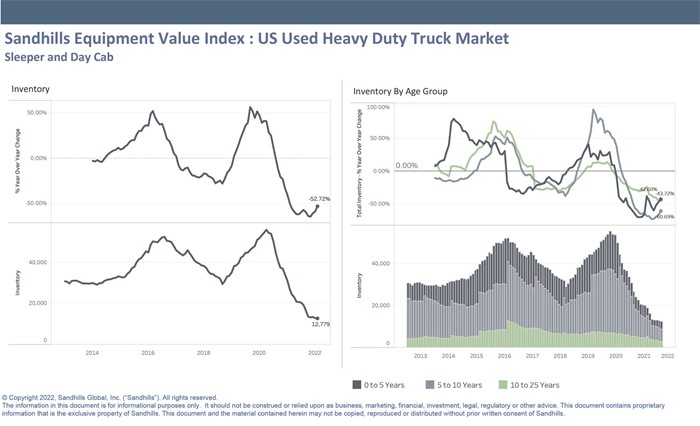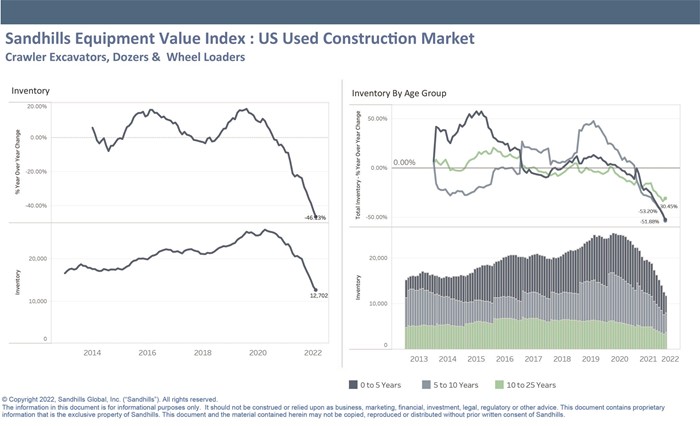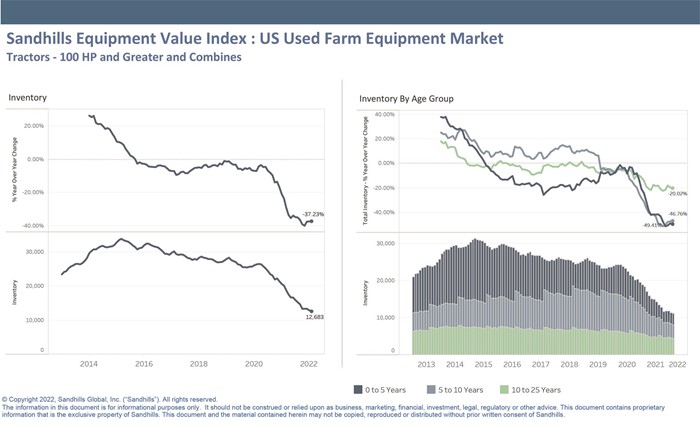November 2025
October 2025
September 2025
August 2025
July 2025
June 2025
May 2025
April 2025
March 2025
February 2025
January 2025
December 2024
Inventory Levels Show Signs of Life in Certain Truck and Construction Equipment Segments
The latest Sandhills Global Market Reports point to inventory level improvements within certain age groups in Sandhills’ truck and construction equipment marketplaces. While used farm equipment inventory remains fairly flat month-over-month since Q4 2021, inventory levels among late-model trucks and construction equipment aged 10 to 25 years posted increases.
The key metric used in all of Sandhills’ market reports is the Sandhills Equipment Value Index (EVI). Buyers and sellers can use the information in the Sandhills EVI to monitor equipment markets and maximize returns on acquisition, liquidation, and related business decisions. For 2022, Sandhills has enhanced its EVI with new metrics. The data now includes model year equipment actively in use, which grows the used equipment population beyond that available in auction and retail markets. New EVI data, already available for the United States, is also now available for Canada to better reflect machine values by location. The enhanced version of Sandhills EVI requires Sandhills to restate the values starting in January 2022, so prior numbers will not be comparable to the new, more insightful values.
Chart Takeaways
Sandhills Market Reports highlight the most significant changes in Sandhills’ used heavy-duty truck, construction equipment, and farm machinery markets. Each report includes detailed analysis and charts that help readers visualize the data. The current reports include charts showing year-over-year and M/M inventory levels overall and by age group across all three markets.
U.S. Used Heavy-Duty Trucks
- Overall heavy-duty truck inventory remained fairly flat M/M for the fourth month in a row following a steady decline that began in April 2020.
- Inventory was down 52.7% YOY in February 2022 compared to February 2021, which marked a nearly 6-percentage-point improvement over January 2022. An upswing in late-model truck inventory levels drove that change.
- Specifically, trucks in the 0- to 5-year age group showed a 6% increase in February compared to January, signaling that production of new equipment may be driving late-model equipment to the used market.
U.S. Used Heavy-Duty Construction Equipment
- Used construction equipment inventory was down 46.1% YOY in February, a further drop from the 42.5% YOY decline posted in January.
- Late-model construction equipment inventory continued to show a M/M decline as well, down 26% in February, driving the overall trend down.
- Late-model (0- to 5-year) construction equipment inventory levels remained flat YOY in February, continuing a steady decline since February 2021.
- The 10- to 25-year age group, however, showed a noticeable improvement, up 12% in February compared to January.
U.S. Used Farm Equipment
- Unlike the used truck and construction equipment markets, used farm equipment inventory levels continued to remain flat in terms of both YOY and M/M figures.
- Farm equipment inventory was down 37.2% YOY in February; by contrast, inventory was down 37.4% YOY in January.
- Across all age groups, farm equipment inventory levels have been roughly flat M/M since Q4 2021 following a steady decline that began in mid-2020.
Obtain the Full Report
For more information, or to receive detailed analysis from Sandhills Global, contact us at [email protected].
About the Sandhills Equipment Value Index
The Sandhills Equipment Value Index (EVI) is a principal gauge of the estimated market values of used assets—both currently and over time—across the construction, agricultural, and commercial trucking industries represented by Sandhills Global marketplaces, including AuctionTime.com, TractorHouse.com, MachineryTrader.com, TruckPaper.com, and other industry-specific equipment platforms. Powered by FleetEvaluator, Sandhills’ proprietary asset valuation tool, Sandhills EVI provides useful insights into the ever-changing supply-and-demand conditions for each industry.



